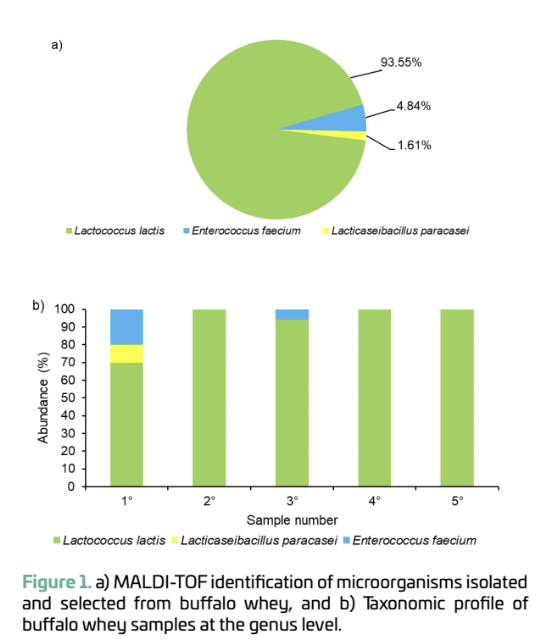Buffalo whey as a source of lactic acid bacteria of biotechnological interest
DOI:
https://doi.org/10.21708/avb.2024.18.4.12671Resumo
Whey has garnered research interest due to its high nutritional value and environmental impact, as it is a sourceof microorganisms that can be isolated and characterized for their functional properties. This study aimed to evaluate buffalowhey as a source of lactic acid bacteria (LAB) with biotechnological potential. Buffalo whey was obtained through enzymaticcoagulation, and its physicochemical and microbiological properties were analyzed. LAB enumeration and isolation were con-ducted using selective media, specifically Man, Rogosa, and Sharpe (MRS) and M17. The isolates were identified via MALDI-TOF, and their enzymatic activity, safety, and antimicrobial effects againstEscherichia coliATCC 10536,Pseudomonas aeruginosaATCC 27853,Listeria monocytogenesATCC 7644, andStaphylococcus aureusATCC 25923 were assessed. The buffalo wheycomplied with the minimum physicochemical and microbiological standards set by IN No. 94/2020, indicating that goodagricultural practices and good manufacturing practices were followed during both milking and processing. A total of 62 LABstrains were isolated and identified via MALDI-TOF-MS, includingLacticaseibacillus paracasei(1.61%),Enterococcus faecium(4.84%), andLactococcus lactis(93.55%). Of these isolates, 98.38% were proteolytic, 83.87% exhibited lipolytic activity, andnone produced lecithinase. The LAB isolates demonstrated antimicrobial activity against the Gram-positive pathogens tested,and 46.77% of the strains were considered innocuous. In summary, buffalo whey presents viable properties and has enabledthe isolation of LAB strains with promising potential for applications in bioprocesses and functional studies.
Downloads

Downloads
Publicado
Edição
Seção
Licença
Copyright (c) 2024 Acta Veterinaria Brasilica

Este trabalho está licenciado sob uma licença Creative Commons Attribution 4.0 International License.
Autores que publicam na Acta Veterinaria Brasilica concordam com os seguintes termos: a) Autores mantém os direitos autorais e concedem à revista o direito de primeira publicação, com o trabalho simultaneamente licenciado sob a Licença Creative Commons Attribution que permite o compartilhamento do trabalho com reconhecimento da autoria e publicação inicial nesta revista. b) Autores têm autorização para assumir contratos adicionais separadamente, para distribuição não-exclusiva da versão do trabalho publicada nesta revista (ex.: publicar em repositório institucional ou como capítulo de livro), com reconhecimento de autoria e publicação inicial nesta revista. c) Autores têm permissão e são estimulados a publicar e distribuir seu trabalho online (ex.: em repositórios institucionais ou na sua página pessoal) a qualquer ponto antes ou durante o processo editorial, já que isso pode gerar alterações produtivas, bem como aumentar o impacto e a citação do trabalho publicado (Veja O Efeito do Acesso Livre).


 Esta obra está licenciada com uma Licença
Esta obra está licenciada com uma Licença 